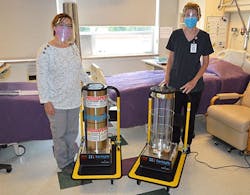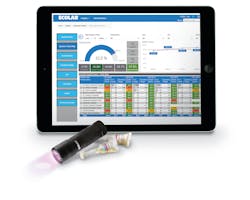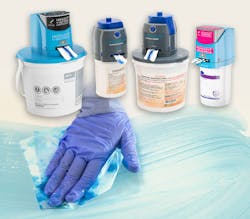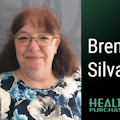Infection prevention solutions worth watching
Benjamin Franklin once said, “An ounce of prevention is worth a pound of cure,” meaning that it’s easier to prevent something from happening in the first place, than be faced with the consequences after it’s happened. Today, the same can be said about preventing infections—especially in the case of life-threatening infections such as influenza, sepsis, and most recently, COVID-19—that it’s better to prevent an infection if possible than deal with the after-effects of a deadly infection.
With that in mind, the question remains: to what degree can hospitals and healthcare facilities prevent infection for the health and safety of employees and patients alike? The answer to this question is being found at companies and facilities that are taking the idea of best practices in infection prevention (IP) beyond the minimum requirements. As evidenced by the innovative products and technology that follow, successful IP solutions can easily be described as contagious ideas worth catching.
Success starts with sanitization
As a growing trend in air and surface cleaning and disinfection, germicidal ultraviolet (UV) systems have proven successful at purifying air and exposed surfaces. These systems succeed in their efforts by using UV wavelengths in dosages that are lethal to infectious microorganisms such as bacteria, mold, and viruses.
At Atlantic Ultraviolet, located in Hauppauge, N.Y., the Sanidyne portable area sanitizers are designed using germicidal UV-C wavelength lamps to disinfect both air and exposed surfaces in unoccupied rooms up to 1,000 square feet in under an hour. The sanitizers are considered efficient and easy to use, are available in four different models, and can accommodate rooms up to 3,500 square feet.
As part of the Sanidyne product success story, the Veterans Memorial Hospital in Allamakee County, Iowa, purchased two Sanidyne UV sanitizers in 2020, which have since proved a wise financial investment, as well as a benefit to patient rooms and other areas of the hospital. After each patient discharge, housekeeping does routine cleaning and then sanitizes rooms with UV-C disinfection for 30 minutes.
Rose Ann Mark, housekeeping supervisor, added, “Our Sanidyne models are a clean, safe way to sanitize surfaces and the air we breathe. Our department has peace of mind knowing every room has had this extra sanitization. Sanidyne is large enough to sanitize an entire room, and is easy to use. It will be an important tool in our housekeeping process for years to come.”
She continued, “In the operating room, patients are often at heightened risk for infection, and collaboration is most critical, with turnover time in the OR being as fast as 15 minutes, compared to a standard patient room, where it may be closer to an hour. In standard patient rooms, an EVS technician is usually assigned to the room with clarity on the cleaning assignment. In the OR, a collection of staff between cases—including OR technicians, nurses, EVS staff, and anesthesia techs—is tasked with cleaning, making team collaboration critical to reducing the risk of infection. With that many people cleaning a room simultaneously, it is important to define responsibilities. Otherwise, certain surfaces and tasks can be missed as one individual assumes another is cleaning a particular area.”
Henken suggested, “One way to drive improved outcomes is through zone cleaning, which clearly defines the responsibilities of each person. Spending precious time outlining these responsibilities sometimes feels counterintuitive, but in the long run, if done successfully, it can result in more efficient and effective cleaning. An example of zone cleaning responsibilities could include one person cleaning all surfaces around the OR table (like hood lights, belt, controls on a table, mattress, etc.), one person cleaning anesthesia equipment (like machine, cart, and IV pole), and a third person cleaning surfaces around the perimeter of the room. In a process like this, everyone is clear on their tasks, which minimizes the chances of a surface not being disinfected.”
She noted, “The relationship between Infection Preventionist (IP) and Sterile Processing Departments (SPD) should be one of trust, respect, and partnership. IPs are some of the brightest and most well respected members of the healthcare system. However, most will freely admit to a scarcity of knowledge surrounding specialty areas such as SPD. Usually, the daily intricacies of the processes can equate to speaking a foreign language to anyone who does not work in the department, IP included. This absence of understanding is primarily due to a lack of in-depth exposure, SPD managers’ and staff’s perceptions of IP’s role, and an unwillingness to invite them in. However, the foundation of a great relationship can be formed through the vulnerability of not knowing and openness to learning from both departments.”
Further asserting the importance of IP and SPD working together, Elammari cited an example of the benefit of department teams having a symbiotic relationship.
“One situation where the importance of this relationship and understanding was made evident was during the construction stages of our SPD department. Prior to construction, our IP spent time in SPD learning processes according to regulations, standards, and industry recommendations, and became very familiar with the AAMI standards. It was during a meeting later in the construction process, where the leadership group was reviewing a new set of updated blueprints, when our IP quickly realized that the new blueprint for decontamination had variations in the location and connections for some of the equipment.”
Elammari continued, “These variations would cause issues with the insulation of needed equipment and make the workflow inconsistent with standards. In addition to the lack of proper workflow and the extra work for staff (crossing decontamination four times for each tray), if not caught, the result would have been a significant financial hit for the hospital and a delay in construction time. Our IP was so happy that she was able to catch the issues because she knew SPD and the standards.”
Optimum operating organization
One area in hospitals and healthcare facilities that is both the most-used and most in need of infection prevention is the operating room/surgical suite. The daily turnover in a typical OR can be such that the cleaning/disinfection staff must work effectively between patients and procedures to ensure all bacteria and viral microbes have been removed. In addition to efficient cleaning and sterilization, OR turnover scheduling must also be as seamless as possible.
At Ecolab, located in Saint Paul, MN, efficiency and effectiveness are their goals, with a new digital program designed to ensure their goals are achieved in hospitals and surgery centers.
She added, “Through our professional training of staff, both in-person and on-demand, teams learn how to work together efficiently and effectively. We recently launched OR Program Reinforced, which is a digital training element to help hospitals improve the quality and consistency of clean for this critical care area. Ecolab OR Program Reinforced includes a library of over 30 interactive lessons on industry best practices for hospital OR turnover teams anytime and anywhere, helping managers onboard new team members, while also reinforcing important processes with existing staff. Efficiency is key when it comes to OR room turns. Everyone following the same process every single time.”
Seeing infection prevention in 3D: dye, dispense, and disinfect
Among the many cleaning and sterilization products designed for the healthcare industry, verifying their effectiveness can be time-consuming and costly. This is true of products that are marketed and purchased based on a high percentage of promised sterilization, but can only live up to their potential when used correctly and completely.
As a prime example, disinfectant wipes are only effective when they wipe an intended area or item completely, without missing anything. But, because the solution used on the wipes is clear, there is no way to ensure every area was wiped thoroughly unless follow-up tests are done to identify any remaining bacteria. This process would not only require time and labor, but it would also affect the workflow of a hospital or healthcare facility. All of these items required would equate to additional facility costs as well.
As an innovative disinfection solution, Kinnos, located in Brooklyn, N.Y., developed its Highlight system for wipes, which succeeds where other products fail by making disinfectants visible.
According to Kinnos’ product description, the Highlight system “is available for ready-to-use wipes across the three most commonly used chemistries of bleach, quaternary ammonium, and hydrogen peroxide through an innovative delivery lid that fits on existing wipes and adds the dye as it dispenses wipes. It fits into existing workflow without disrupting or altering the cleaning process. The blue color gives instant visibility to confirm coverage, then fades to clear in a few minutes to remind of contact time, and requires no other steps by users.”
She added, “Through its function, the Highlight system allows us to identify surfaces that require additional cleaning and disinfecting, including maintenance, repair or replacement. The Highlight system is one of the first innovations we have introduced that can be directly used by housekeeping, nursing, care and clinical employees, providing the opportunity for multiple levels of increased infection control.”
Peer-reviewed evidence offered by Kinnos shows that Highlight improves cleaning scores by 70 to 95% in just weeks, and that modest improvements in cleaning scores translate to significant drops in healthcare infection rates. Currently, Highlight is the only technology providing instant real-time feedback for cleaning staff.
Give infection prevention a hand…sanitizer
While soap and water have traditionally been the main stars on the infection prevention stage, the use of hand sanitizer was often regarded as a back-up option for hand cleaning that paled in comparison, but was better than nothing in a pinch. But 2019 changed that way of thinking when COVID-19 showed up in the U.S., and hand sanitizer products were thrust into the spotlight.
As COVID-19 appeared more and more nationwide, hand sanitizer products were available less and less, leading to many home recipes and overpriced one-off brands for sale as substitutes. Luckily, the mad panic that ensued has subsided, and hand sanitizers are easy to find in stores once again. In addition to community availability, hand sanitizer products are also reestablishing their importance in hospitals and healthcare facilities.
“Despite broad acknowledgement of the critically important role of hand hygiene in reducing the transmission of pathogenic microorganisms, overall compliance with hand hygiene is less than optimal in most healthcare settings. Healthcare worker’s hands are their most relied upon “tools” but they can also be a conduit for infection spread.”
She continued, “The Centers for Disease Control (CDC) and the World Health Organization (WHO) have created several educational aids available to staff that demonstrate how and when to use hand sanitizers. In addition, facilities hold training and refresher sessions for staff, and direct-observation audits are conducted to enforce routine use. It is the organization’s primary responsibility to provide easy access to hand sanitizers, enforce policy, establish accountability, and ensure overall safety culture. So how can the industry help facilitate adherence to alcohol-based hand sanitizers?”
Padovan noted, “Hand sanitizers are a great example of a ‘subjective’ product to the user. Color, fragrance, sensation, and delivery method play a part in compliance. The sanitizer may be considered sticky or ‘smelly’ by one healthcare worker and not another. The product needs to be well tolerated by most staff. With the Amekina hand sanitizer, a sanitizer gel and foam that has no color or fragrance, of great importance is the addition of emollients to aid by counteracting the drying effect alcohol has on the skin. Our sanitizers have a unique red pump and push dispenser and contain aloe vera and vitamin E to provide softness to the hands, while the 70% alcohol active ingredient gives broad-spectrum antimicrobial pathogen kill.”
She continued, “Purell SMARTLINK technologies provide hospitals with the infrastructure to monitor hand hygiene on a 24/7 basis across units and facilities, generating large volumes of standardized hand hygiene data and providing a more complete picture of hand hygiene practices. These automated data allow Infection Preventionists, unit-level leadership, and other stakeholders to better target their time and energy areas needing intervention.”
Additional study results reported by GOJO showed the adoption of Purell SMARTLINK Service Alerts resulted in a 31% reduction in labor time by more efficiently using FTE resources, a 14% reduction in consumable costs, and a 100% reduction in staff complaints.












